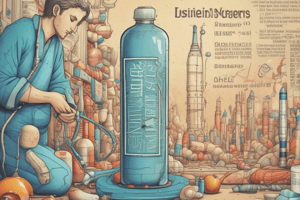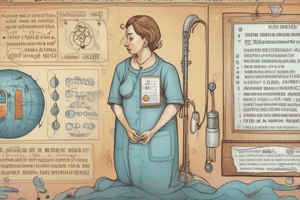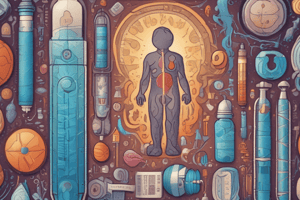Podcast
Questions and Answers
What is a primary management strategy for Type 2 diabetes in obese patients?
What is a primary management strategy for Type 2 diabetes in obese patients?
- Physical exercise alone
- Surgical intervention
- Diet regulation and caloric restriction (correct)
- Insulin therapy only
Which of the following best describes the cause of Type 1 diabetes?
Which of the following best describes the cause of Type 1 diabetes?
- Insulin resistance in target tissues
- Increased blood glucose due to obesity
- Inadequate pancreatic insulin secretion (correct)
- Drug-induced insulin production
Which term is used for a severe complication of diabetes characterized by insufficient insulin leading to high blood glucose levels?
Which term is used for a severe complication of diabetes characterized by insufficient insulin leading to high blood glucose levels?
- Insulin shock
- Diabetic neuropathy
- Hypoglycemic coma
- Diabetic ketoacidosis (correct)
Which of the following classifications of diabetes is associated with pregnancy?
Which of the following classifications of diabetes is associated with pregnancy?
What is the main distinction between Type 1 and Type 2 diabetes?
What is the main distinction between Type 1 and Type 2 diabetes?
Which type of insulin is considered ultrashort-acting?
Which type of insulin is considered ultrashort-acting?
What is a characteristic of long-acting insulin?
What is a characteristic of long-acting insulin?
In which scenario is insulin therapy indicated for NIDDM?
In which scenario is insulin therapy indicated for NIDDM?
Which insulin delivery method is characterized by continuous infusion?
Which insulin delivery method is characterized by continuous infusion?
For which condition is insulin therapy NOT typically indicated?
For which condition is insulin therapy NOT typically indicated?
What triggers insulin release from pancreatic beta cells?
What triggers insulin release from pancreatic beta cells?
Which of the following is NOT a mechanism by which insulin decreases blood glucose levels?
Which of the following is NOT a mechanism by which insulin decreases blood glucose levels?
What type of receptors do insulin act upon?
What type of receptors do insulin act upon?
What is the effect of insulin on fat metabolism?
What is the effect of insulin on fat metabolism?
Which process is influenced by insulin in protein metabolism?
Which process is influenced by insulin in protein metabolism?
Which of the following accurately describes insulin's role in carbohydrate metabolism?
Which of the following accurately describes insulin's role in carbohydrate metabolism?
Which class of drug stimulates insulin secretion from pancreatic beta cells?
Which class of drug stimulates insulin secretion from pancreatic beta cells?
How does insulin affect hepatic glucose production?
How does insulin affect hepatic glucose production?
What is one of the primary indications for insulin use in non-diabetic patients?
What is one of the primary indications for insulin use in non-diabetic patients?
Which type of diabetes is often associated with insulin dependence?
Which type of diabetes is often associated with insulin dependence?
What is a potential adverse effect of insulin therapy?
What is a potential adverse effect of insulin therapy?
Which of the following conditions may require a patient to shift from oral antidiabetic agents to insulin?
Which of the following conditions may require a patient to shift from oral antidiabetic agents to insulin?
What should be done to address insulin resistance in patients on insulin therapy?
What should be done to address insulin resistance in patients on insulin therapy?
Which adverse effect of insulin therapy is characterized by abnormal fat distribution?
Which adverse effect of insulin therapy is characterized by abnormal fat distribution?
Which of the following conditions is contraindicated for the use of insulin?
Which of the following conditions is contraindicated for the use of insulin?
What is a rare adverse effect associated with human insulin?
What is a rare adverse effect associated with human insulin?
What is a common adverse effect associated with insulin resistance?
What is a common adverse effect associated with insulin resistance?
Which of the following incretins is involved in promoting insulin secretion?
Which of the following incretins is involved in promoting insulin secretion?
Incretin therapy targeting GLP-1 involves the use of what type of medication?
Incretin therapy targeting GLP-1 involves the use of what type of medication?
What is a significant caution regarding the use of oral antidiabetic agents?
What is a significant caution regarding the use of oral antidiabetic agents?
What warning sign is associated with hypoglycemic coma?
What warning sign is associated with hypoglycemic coma?
What treatment option is recommended for hypoglycemic coma?
What treatment option is recommended for hypoglycemic coma?
What enzyme rapidly degrades active incretins?
What enzyme rapidly degrades active incretins?
Which of the following symptoms is NOT a neurological sign associated with hypoglycemia?
Which of the following symptoms is NOT a neurological sign associated with hypoglycemia?
What is the primary mechanism of action for biguanides like Metformin?
What is the primary mechanism of action for biguanides like Metformin?
Which side effect is most commonly associated with Metformin?
Which side effect is most commonly associated with Metformin?
What is the role of thiazolidinediones (TZDs) in diabetes management?
What is the role of thiazolidinediones (TZDs) in diabetes management?
In which of the following conditions is Metformin indicated?
In which of the following conditions is Metformin indicated?
Which of the following is NOT a side effect associated with long-term Metformin use?
Which of the following is NOT a side effect associated with long-term Metformin use?
What role do selective agonists for PPAR gamma play in diabetes management?
What role do selective agonists for PPAR gamma play in diabetes management?
What effect does Metformin have on glucose utilization?
What effect does Metformin have on glucose utilization?
Which of the following outcomes is a characteristic of prandial glucose regulators?
Which of the following outcomes is a characteristic of prandial glucose regulators?
Flashcards
Diabetes Mellitus
Diabetes Mellitus
A condition where the body's blood glucose levels are abnormally high due to either insufficient insulin production or impaired insulin action.
Type 1 Diabetes
Type 1 Diabetes
A type of diabetes that is caused by the body's immune system attacking and destroying the insulin-producing cells in the pancreas.
Type 2 Diabetes
Type 2 Diabetes
A type of diabetes that is characterized by insulin resistance, meaning the body's cells do not respond properly to insulin.
Insulin Therapy
Insulin Therapy
Signup and view all the flashcards
Oral Antidiabetic Agents
Oral Antidiabetic Agents
Signup and view all the flashcards
Insulin Release
Insulin Release
Signup and view all the flashcards
Insulin Receptors
Insulin Receptors
Signup and view all the flashcards
Insulin's Metabolic Effects
Insulin's Metabolic Effects
Signup and view all the flashcards
Insulin's Effect on Carbohydrate Metabolism
Insulin's Effect on Carbohydrate Metabolism
Signup and view all the flashcards
Insulin's Effect on Fat Metabolism
Insulin's Effect on Fat Metabolism
Signup and view all the flashcards
Insulin's Effect on Protein Metabolism
Insulin's Effect on Protein Metabolism
Signup and view all the flashcards
Insulin Preparations
Insulin Preparations
Signup and view all the flashcards
Insulin Types: Ultrashort, Short, Intermediate, Long-acting
Insulin Types: Ultrashort, Short, Intermediate, Long-acting
Signup and view all the flashcards
What are some examples of Ultrashort-Acting Insulins?
What are some examples of Ultrashort-Acting Insulins?
Signup and view all the flashcards
What type of insulin is regular insulin?
What type of insulin is regular insulin?
Signup and view all the flashcards
Explain why Isophane NPH insulin is an intermediate-acting option.
Explain why Isophane NPH insulin is an intermediate-acting option.
Signup and view all the flashcards
What types of insulin are Glargine and Detemir?
What types of insulin are Glargine and Detemir?
Signup and view all the flashcards
Hypoglycemic coma
Hypoglycemic coma
Signup and view all the flashcards
Diabetic ketoacidosis (DKA)
Diabetic ketoacidosis (DKA)
Signup and view all the flashcards
Type 1 Diabetes (IDDM)
Type 1 Diabetes (IDDM)
Signup and view all the flashcards
Type 2 Diabetes (NIDDM)
Type 2 Diabetes (NIDDM)
Signup and view all the flashcards
Insulin resistance
Insulin resistance
Signup and view all the flashcards
Lipodystrophy
Lipodystrophy
Signup and view all the flashcards
Insulin allergy
Insulin allergy
Signup and view all the flashcards
Increased cancer risk
Increased cancer risk
Signup and view all the flashcards
Biguanides
Biguanides
Signup and view all the flashcards
Metformin
Metformin
Signup and view all the flashcards
Lactic Acidosis
Lactic Acidosis
Signup and view all the flashcards
Vitamin B12 Deficiency
Vitamin B12 Deficiency
Signup and view all the flashcards
Thiazolidinediones (TZDs)
Thiazolidinediones (TZDs)
Signup and view all the flashcards
PPARγ (Peroxisome Proliferator-Activated Receptor Gamma)
PPARγ (Peroxisome Proliferator-Activated Receptor Gamma)
Signup and view all the flashcards
Rosiglitazone
Rosiglitazone
Signup and view all the flashcards
Pioglitazone
Pioglitazone
Signup and view all the flashcards
What is insulin resistance?
What is insulin resistance?
Signup and view all the flashcards
What are incretins?
What are incretins?
Signup and view all the flashcards
How do DPP-4 inhibitors work?
How do DPP-4 inhibitors work?
Signup and view all the flashcards
How do GLP-1 receptor agonists work?
How do GLP-1 receptor agonists work?
Signup and view all the flashcards
What is hypoglycemic coma?
What is hypoglycemic coma?
Signup and view all the flashcards
What is diabetic ketoacidosis?
What is diabetic ketoacidosis?
Signup and view all the flashcards
How is hypoglycemic coma treated?
How is hypoglycemic coma treated?
Signup and view all the flashcards
How is diabetic ketoacidosis treated?
How is diabetic ketoacidosis treated?
Signup and view all the flashcards
Study Notes
Anti-Diabetic Drugs
- Anti-diabetic drugs are used to manage diabetes.
- Diabetes mellitus involves elevated blood glucose levels.
- Types of diabetes include Type 1, Type 2, and gestational diabetes.
- Diabetic comas include hypoglycemic coma and diabetic ketoacidosis.
Diabetes Mellitus: Definition
- Diabetes mellitus is characterized by either absent or inadequate pancreatic insulin secretion or impairment of insulin actions.
- Elevated blood glucose levels are a key indicator of diabetes mellitus.
Diabetes Mellitus: Classification
- Type 1 diabetes is also known as IDDM (Insulin-Dependent Diabetes Mellitus).
- Type 2 diabetes, also known as NIDDM (NonInsulin-dependent Diabetes Mellitus) is the most common type and often related to the long-term use of corticosteroids.
- Gestational diabetes occurs during pregnancy.
- Diabetes can also be caused by drugs, such as glucocorticoids.
Diabetes Mellitus: Management
- Diet regulation with caloric restriction, especially for obese Type II patients, is a key component of management.
- Physical exercise plays an important role.
- Medications, including insulin therapy and oral antidiabetic agents, are a crucial part of diabetes management.
Insulin Release
- Glucose triggers insulin release from pancreatic beta cells.
- Sulfonylurea drugs facilitate insulin release by blocking potassium channels, leading to depolarization.
- The process involves ATP, potassium channels, calcium influx, and exocytosis.
Insulin Therapy: Mechanism of Action
- Insulin acts on tyrosine kinase receptors.
- This action affects metabolic enzymes, controlling carbohydrate, fat, and protein metabolism.
Insulin Therapy: Pharmacological Actions
- Insulin regulates carbohydrate metabolism by decreasing hepatic glucose production and increasing glucose uptake in muscles and fat cells.
- Insulin influences fat metabolism by promoting fat storage.
- Protein metabolism is also affected by insulin, stimulating protein storage.
Insulin Preparations
- Different types of insulin preparations exist with varied durations of action (e.g., ultra-short-acting, short-acting, intermediate-acting, long-acting).
- Ultra-short-acting insulins, such as Lispro, Aspart and Glulisine, typically have a rapid onset and shorter duration of action.
- Intermediate-acting insulin include Isophane NPH insulin.
- Long-acting preparations, such as Insulin glargine, and Detemir insulin, have a prolonged duration of action.
- The duration of action of an insulin preparation is important for adjusting dosages to maintain optimal blood sugar levels.
Insulin Delivery Systems
- Insulin can be delivered by various methods including standard subcutaneous injections, portable pen injectors, continuous subcutaneous infusion devices, and inhaled insulin.
- Portable pen injectors are a convenient method for self-administered insulin.
- Continuous subcutaneous infusion devices, or insulin pumps, offer a more continuous delivery of insulin.
- Inhaled insulin is a recent alternative delivery method.
Indications of Insulin Therapy
- Insulin therapy is indicated in several situations, particularly when dietary regulation and oral medication are ineffective in managing diabetes.
- It may be needed in cases of diabetes with stress, surgery, infection, pregnancy, lactation, severe renal or liver disease, or hyperkalemia.
Adverse Effects of Insulin
- Hypoglycemia, a decrease in blood glucose level, is a significant adverse effect.
- Insulin resistance can occur and weight reduction is often prescribed to overcome this resistance.
- Lipodystrophy is a local effect where fat changes occur at the injection site.
- Allergy is a rare but possible adverse effect, especially with some insulin types.
- Some studies have suggested that there is increased risk of certain types of cancers in individuals using insulin.
Oral Antidiabetic Agents
- Different classes of oral anti-diabetic agents exist including those that enhance insulin action In peripheral tissues, and those that enhance endogenous secretions.
Sulfonylureas (SU)
- Sulfonylureas are a class of oral antidiabetic drugs that enhance insulin secretion.
Sulfonylureas (SU): Mechanism of Action
- Sulfonylureas stimulate insulin release by closing ATP-sensitive potassium channels.
- This action depolarizes the cell membrane, leading to calcium influx, and ultimately insulin release.
Sulfonylureas (SU): Indications
- Sulfonylureas are used to treat non-obese individuals with Type 2 diabetes who do not respond sufficiently to other treatments or who have had diabetes for 5-10 years.
Sulfonylureas (SU): Adverse Effects
- Common adverse effects include hypoglycemia, hypersensitivity, and weight gain.
- Some individuals might experience cholestatic jaundice, disulfiram-like effects (e.g., vomiting, flushing), or dilutional hyponatremia, with certain drugs in this class.
Non-SU Secretagogues (Glinides)
- These drugs are like sulfonylureas, but they have a quicker onset and shorter duration of action.
- They are helpful for controlling post-meal blood sugar spikes.
Biguanides (Metformin)
- Metformin is an antidiabetic that impacts hepatic glucose production, improves glucose use in muscle and adipose tissues, and enhances intestinal glucose absorption.
Biguanides (Metformin): Side Effects
- Common side effects include gastrointestinal issues such as metallic taste, nausea, bloating, and diarrhea.
- Lactic acidosis, a serious but less frequent side effect, potentially occurs in individuals with renal impairment.
- Metformin may also interfere with vitamin B12 absorption and can cause deficiencies.
Thiazolidinediones (TZDs):
- Thiazolidinediones, or TZDs, enhance insulin action in peripheral tissues, particularly in skeletal muscle and adipocytes.
Thiazolidinediones (TZDs): Mechanism of Action
- TZDs work by activating peroxisome proliferator-activated receptor gamma (PPAR-γ) receptors, which improves insulin sensitivity.
Thiazolidinediones (TZDs): Adverse Effects & Precautions
- Common adverse effects include weight gain, edema, heart failure, and anemia.
- TZDs should generally be avoided in individuals with compromised liver function.
Incretin Therapy
- Incretins are gut hormones that enhance insulin secretion in response to food intake.
- The incretin effect is reduced in individuals with Type 2 diabetes.
- Drugs stimulating incretin effects and slowing down the enzyme (DPP4) are used to address this reduction.
Comas in DM: Hypoglycemic Coma
- Warning signs include elevated heart rate, sweating, tremors, and hunger pain.
- Neurological signs include weakness, irritability, dizziness, confusion, and convulsions.
- Treatment involves rapid administration of 50% glucose intravenously or glucagon subcutaneously.
Comas in DM: Diabetic Ketoacidosis (DKA)
- DKA is characterized by severe insulin deficiency, often resulting from stopping insulin therapy or increased stress (e.g., infection, illness).
- Warning signs include polyuria, vomiting, and dehydration, and ultimately progressing to coma.
- Investigations typically measure blood glucose, ketones, and other metabolic parameters.
- Management includes fluid replacement, regular insulin infusions, potassium replenishment, and addressing acidosis if needed.
Studying That Suits You
Use AI to generate personalized quizzes and flashcards to suit your learning preferences.




